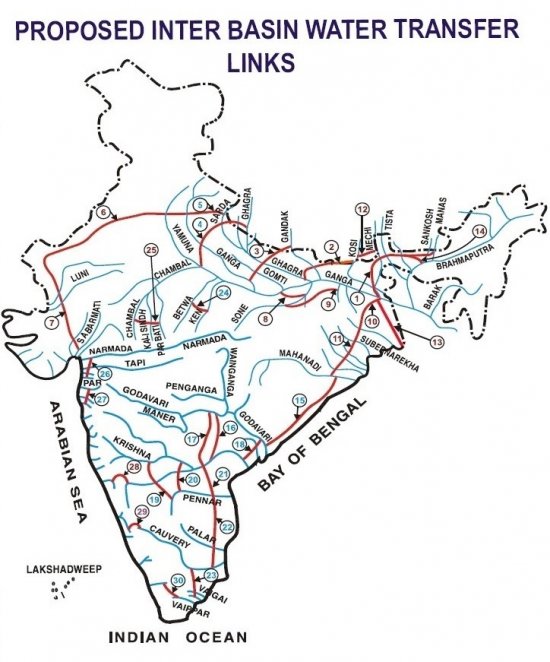Focus: GS-II Governance, Prelims
Why in news?
- The Central government is working on the establishment of an exclusive body, called the National Interlinking of Rivers Authority (NIRA), to implement projects for linking rivers.
- NIRA is expected to take up both inter-State and intra-State projects.
- It will also make arrangements for generating up funds, internally and externally.
- The subject of establishment of the Authority, NIRA, was discussed at the meeting of the Special Committee on Inter-Linking of Rivers (ILR) in February 2020.
ILR in India
- The Indian Rivers Inter-link is a proposed large-scale civil engineering project that aims to effectively manage water resources in India by linking Indian rivers by a network of reservoirs and canals to enhance irrigation and groundwater recharge, reduce persistent floods in some parts and water shortages in other parts of India.
- The Inter-link project has been split into three parts:
- Northern Himalayan rivers inter-link component
- Southern Peninsular component and starting 2005
- Intrastate rivers linking component.
- The project is being managed by India’s National Water Development Agency (NWDA), under its Ministry of Water Resources.
NWDA
- The National Water Development Agency (NWDA), a Registered Society under the Ministry of Water Resources, was set up in the year 1982.
- It was established to carry out the water balance and other studies on a scientific and realistic basis for optimum utilisation of Water Resources of the Peninsular rivers system.
- It was also tasked to prepare feasibility reports and give concrete shape to Peninsular Rivers Development Component of National Perspective.
- In 1990, it was also entrusted with the task of Himalayan Rivers Development Component of National Perspectives. Recently, the functions of NWDA have been further modified and the work of preparation of detailed Project Reports (DPR) of various link proposals and Pre-feasibility Reports.
- It has been also entrusted to prepare feasibility reports of intra-State links as proposed by the States.
ILR Projects in Consideration

As of now, six ILR projects have been under examination of the authorities.—
- Ken-Betwa,
- Damanganga- Pinjal,
- Par-Tapi-Narmada,
- Manas-Sankosh-Teesta-Ganga,
- Mahanadi-Godavari and
- Godavari-Cauvery (Grand Anicut)
With regard to the peninsular rivers, the Centre has chosen to focus on the Godavari-Cauvery link.
Benefits of the Interlinking of River Projects
India receives most of its rain during monsoon season from June to September
Most of it falls in northern and eastern part of India. The amount of rainfall in southern and western part are comparatively low, and hence, these places which will have shortage of water.
- Therefore, Interlinking of rivers will help these areas to have water throughout the year.
- It will reduce the dependence of farmers on monsoon rains.
- Revenues for the States will increase with increasing production of Crops.
- The economic impact of the failure of a single monsoon is very substantial, hence a reduction in the dependency on monsoons rains will reduce the debilitating economic impact.
- It will ease the water shortages in Western and Southern India.
- It will help mitigating the impacts of recurrent floods in Eastern India.
- Water from the basins that are affected by floods almost every year (Ganga, Brahmaputra) can be diverted to other areas where there is scarcity of water; this can be achieved by linking the rivers.
- Thus – There are Advantages in Both – Controlling Floods and Reducing Scarcity of Water.
- The river interlinking project claims to generate total power of 34,000 MW (34 GW) and India needs clean energy to fuel its development processes. Hence the ILR Projects can help with India’s Energy needs.
- Socio-economic life of people will improve as the water needs get fulfilled.
- Inter-state water disputes can also be handled after implementation of ILR Projects.
- Transportation through navigation will Increase Income Sources and increase connectivity.
- Fishing in rural areas can also be improved as a result of ILR Projects.
Arguments Against ILP Projects
- Concerned scholars questioned the merits of inter-link projects citing lack of holistic assessment of social-ecological impacts like water-logging, salinisation and the resulting desertification.
- The concerns about sediment management, especially on the Himalayan system loom large. When the idea is to transfer water from the ‘surplus’ Himalayan river systems to ‘deficit’ basins of the southern part of India, the differential sediment regime defining the flow regimes need to be plugged into the equation. This will entail changes in ecosystem structures in both parts.
- Damming India’s east-coast rivers to take their water westwards will curtail downstream flooding and thereby, the supply of sediment—a natural nutrient—destroying fragile coastal ecosystems and causing coastal and delta erosion
- The spirit of federalism is ignored in the river interlinking project. There is dissent on the part of the state governments (Kerala).
Way Forward
- Local solutions (like better irrigation practice) and watershed management, should be focused on.
- The government should alternatively consider the National Waterways Project (NWP) which “eliminates” friction between states over the sharing of river waters since it uses only the excess flood water that goes into the sea unutilized
- The necessity and feasibility of river-interlinking should be seen on case to case basis, with adequate emphasis on easing out federal issues.




